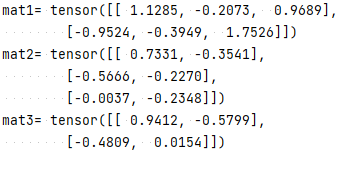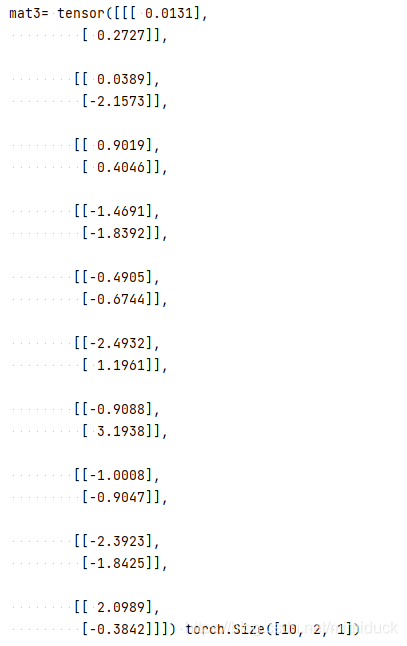【pytorch】torch.mm,torch.bmm以及torch.matmul的使用
torch.mmtorch.mm是两个矩阵相乘,即两个二维的张量相乘如下面的例子mat1 = torch.randn(2,3)print("mat1=", mat1)mat2 = torch.randn(3,2)print("mat2=", mat2)mat3 = torch.mm(mat1, mat2)print("mat3=", mat3)但是如果维度超过二维,则会报错。RuntimeErro
torch.mm
torch.mm是两个矩阵相乘,即两个二维的张量相乘
如下面的例子
mat1 = torch.randn(2,3)
print("mat1=", mat1)
mat2 = torch.randn(3,2)
print("mat2=", mat2)
mat3 = torch.mm(mat1, mat2)
print("mat3=", mat3)

但是如果维度超过二维,则会报错。RuntimeError: self must be a matrix
torch.bmm
它其实就是加了一维batch,所以第一位为batch,并且要两个Tensor的batch相等。
第二维和第三维就是mm运算了,同上了。
示例代码如下:
mat1 = torch.randn(10, 2, 4)
# print("mat1=", mat1)
mat2 = torch.randn(10, 4, 1)
# print("mat2=", mat2)
mat3 = torch.matmul(mat1, mat2)
print("mat3=", mat3, mat3.shape)

torch.matmul
torch.mm仅仅是供矩阵相乘使用,使用范围较为狭窄。
而torch.matmul使用的场合就比较多了。
如官方文档所介绍,有如下几种:
- If both tensors are 1-dimensional, the dot product (scalar) is returned.
如果两个tensor都是一维的,则为点乘运算,即每个元素对应相乘求和
如下:
mat1 = torch.Tensor([1,2])
print("mat1=", mat1)
mat2 = torch.Tensor([1,2])
print("mat2=", mat2)
mat3 = torch.matmul(mat1, mat2)
print("mat3=", mat3)
公式如下:
A
=
[
a
1
,
a
2
,
.
.
.
,
a
n
]
B
=
[
b
1
,
b
2
,
.
.
.
,
b
n
]
m
a
t
m
u
l
(
A
,
B
)
=
∑
i
a
i
b
i
A=[a_1,a_2 ,..., a_n] \newline B=[b_1,b_2 ,..., b_n] \newline matmul(A,B)=\sum_{i}a_ib_i
A=[a1,a2,...,an]B=[b1,b2,...,bn]matmul(A,B)=i∑aibi
样例代码如下:

-
If both arguments are 2-dimensional, the matrix-matrix product is returned.
如果两个都是二维的,那么就如同torch.mm -
If the first argument is 1-dimensional and the second argument is 2-dimensional, a 1 is prepended to its dimension for the purpose of the matrix multiply. After the matrix multiply, the prepended dimension is removed.
如果第一个入参是一维的,第二个入参是二维的,则第一个参数增加一个一维,做矩阵乘法,结果然后去掉一维
如, 第一参数A shape为(2),第二参数B shape(2,2),
先讲A增加一维,shape为(1,2),然后计算矩阵相乘
结果为(1,2),再去掉第一维,改为(2)
代码样例如下:
mat1 = torch.Tensor([1,-1])
print("mat1=", mat1)
mat2 = torch.Tensor([[1,2],[-1,-2]])
print("mat2=", mat2)
mat3 = torch.matmul(mat1, mat2)
print("mat3=", mat3, mat3.shape)

- If the first argument is 2-dimensional and the second argument is 1-dimensional, the matrix-vector product is returned.
如果第一个入参是二维的,第二个是一维,则将第二个参数扩展一维,做矩阵乘法。
如, 第一参数A shape为(2,2),第二参数B shape(2),
先将B增加一维,shape为(2,1),然后计算矩阵相乘
结果为(2,1),再去掉第一维,改为(2)
代码样例如下:
mat1 = torch.Tensor([[1,2],[-1,-2]])
print("mat1=", mat1)
mat2 = torch.Tensor([1,-1])
print("mat2=", mat2)
mat3 = torch.matmul(mat1, mat2)
print("mat3=", mat3, mat3.shape)

- If both arguments are at least 1-dimensional and at least one argument is N-dimensional (where N > 2), then a batched matrix multiply is returned. If the first argument is 1-dimensional, a 1 is prepended to its dimension for the purpose of the batched matrix multiply and removed after. If the second argument is 1-dimensional, a 1 is appended to its dimension for the purpose of the batched matrix multiple and removed after. The non-matrix (i.e. batch) dimensions are broadcasted (and thus must be broadcastable). For example, if input is a (j \times 1 \times n \times n)(j×1×n×n) tensor and other is a (k \times n \times n)(k×n×n) tensor, out will be a (j \times k \times n \times n)(j×k×n×n) tensor
最后一个看的很复杂,实际上需要明白2点:
一,两边shape的rank要相同,最后两维是用来做mm计算的
二,如果shape的rank不同,则可以通过“broadcast”,即+1维。 如shape(10,4,2)matmul shape(2,3)则变为 shape(10,4,2)matmul shape(1,2,3)
但是要注意:
- 如果是shape(10,4,2)matmul shape(2,2,3)会报错,因为batch不匹配
- 如果是shape(2,3, 2, 4)matmul shape(2, 4, 1),也会报错。因为batch (2,3)不匹配 (2)
- 但是shape(2,3, 2, 4)matmul shape(3, 4, 1) 是可以的,因为 shape(3, 4, 1) 可以通过broadcast转为shape(1,3, 4, 1)
对比numpy
相对numpy,有类似函数tensordot,具体可以参考我这一篇,但是个人觉得还是numpy的实现更灵活一些
更多推荐
 已为社区贡献6条内容
已为社区贡献6条内容









所有评论(0)